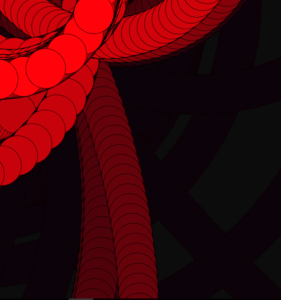For this animation sketch, I tried to show the principles of solid animation, slow in and slow out, and arcs. Originally, I wanted to recreate a basketball bouncing up and down and slowing down because of gravity. Then after I accidentally changed a variable, it created what looked like a basketball being bounced towards the screen. I thought this animation looked a lot cooler so I decided to go with it. It appears as though the ball travels in an arc towards the viewer’s screen. Also, it looks as though the basketball speeds up mid-bounce; the basketball starts slow, speeds up as it gets closer to the screen and then slows down again when it is right in front of the viewer. The hardest part was trying to incorporate solid animation; I wanted to make a sphere rather than just an ellipse. I had to make my sketch 3D; I explored the processing website to learn about how to control the ball’s location and how to make the shape bigger and smaller.
https://www.openprocessing.org/sketch/509171

